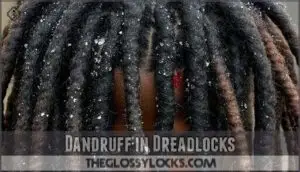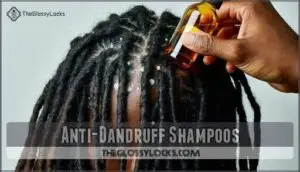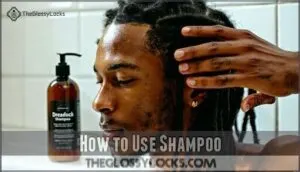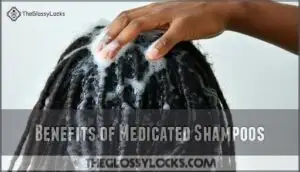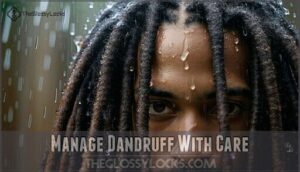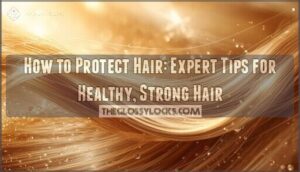This site is supported by our readers. We may earn a commission, at no cost to you, if you purchase through links.
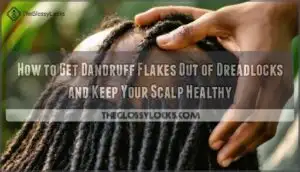
Rinse thoroughly, letting water flow through each lock without excessive scrubbing. Follow up with a lightweight oil, like tea tree or jojoba, to hydrate your scalp without clogging pores.
Stay consistent with your wash routine, and avoid product buildup by moisturizing sparingly. Treat your scalp gently—think of it as a garden that thrives with care—and your dreadlocks will thank you.
Table Of Contents
- Key Takeaways
- Dandruff in Dreadlocks
- Get Dandruff Flakes Out
- Treat Dandruff With Shampoo
- Natural Remedies for Dandruff
- Prevent Dandruff Recurrence
- Manage Dandruff With Care
- Frequently Asked Questions (FAQs)
- How do you dissolve dandruff flakes in locs?
- How to remove dandruff flakes stuck in hair?
- How to remove dead skin from dreadlocks?
- Should you comb out dandruff flakes?
- Can swimming affect dandruff in dreadlocks?
- How does climate impact dandruff in locs?
- Are there age-specific dandruff treatments for locs?
- Can hair dye worsen dandruff in dreadlocks?
- How often should dreadlocks be trimmed for dandruff control?
- Can dandruff affect hair growth in dreadlocks?
- Conclusion
Key Takeaways
- Use a clarifying anti-dandruff shampoo with ingredients like ketoconazole or zinc pyrithione to clean your scalp and remove flakes effectively.
- Gently massage your scalp while washing to loosen flakes and improve blood flow, and rinse thoroughly to avoid buildup.
- Apply lightweight oils like tea tree or jojoba to hydrate your scalp without clogging pores or weighing down your locs.
- Stick to a consistent wash routine and avoid using heavy products that can trap flakes and irritate your scalp.
Dandruff in Dreadlocks
Dandruff in dreadlocks can be tricky, as the tightly bound hair makes it harder to remove flakes and maintain a clean scalp.
Tightly bound dreadlocks make scalp care a challenge, but with the right routine, flake-free, healthy locs are within reach.
Understanding what causes dandruff and how it affects your locs is the first step to keeping both your hair and scalp healthy.
Causes of Dandruff
Dandruff in dreadlocks often stems from yeast overgrowth and sebum buildup.
Internal triggers like stress, hormonal changes, and diet shifts can disrupt scalp health, while external factors like infrequent washing or improper shampooing worsen flakes.
High scalp pH encourages yeast growth, leading to irritation and dreadlock flakes, think of it as your scalp protesting against imbalance—keep it clean and calm!
Symptoms of Dandruff
An itchy scalp often signals dandruff, with visible flakes being the most obvious clue.
You might notice scalp redness or a mix of dry scalp and oily scalp patches, especially near your dreadlocks.
Flaking can get stuck in locs, making it harder to manage.
That annoying itch? It’s your scalp’s way of begging for attention and care!
Effects on Scalp Health
When your scalp’s irritated, it’s like a garden struggling to grow.
Dreadlock dandruff disrupts sebum balance, leading to inflammation that stunts hair growth.
Flaky buildup messes with pH levels, inviting yeast overgrowth and worsening itchy scalp dreads.
Ignoring dreadlock flakes causes long-term damage, but inflammation reduction and itch relief can restore scalp health, helping your dreadlocks thrive like they’re meant to.
Maintaining a balanced scalp microbiome is key to preventing these issues.
This is because scalp health impacts hair growth.
Get Dandruff Flakes Out
When those pesky flakes make an appearance, getting them out of your dreadlocks takes some care and technique.
Pesky flakes? Treat your locs like a treasure—gentle care and smart techniques keep them flake-free and thriving!
Start with gentle exfoliation to loosen flakes—use your fingertips, not nails, to avoid hurting your scalp.
A soothing scalp massage can help by dislodging stubborn buildup while promoting blood flow.
For an itchy scalp with dreads, try a residue-free product application designed for dry scalp locs.
Afterward, use proper combing techniques with a wide-tooth comb, gently targeting visible flakes without tugging on your locs.
If dreadlock dandruff lingers, pairing these methods with consistent care works wonders.
Remember, clean locs mean a healthy scalp!
Think of it like dusting off a treasure—your dreads deserve that loving attention for lasting flake-free confidence.
Addressing the Malassezia fungal overgrowth can further help to reduce dandruff.
Treat Dandruff With Shampoo
Using the right shampoo is key to tackling dandruff in your dreadlocks and keeping your scalp healthy.
Choose a medicated, residue-free formula to target flakes, reduce irritation, and leave your locs clean without buildup.
Anti-Dandruff Shampoos
When tackling dreadlock dandruff, choosing the right antidandruff shampoo makes all the difference.
Look for shampoo ingredients like zinc pyrithione or ketoconazole, effective against yeast. Residue-free options help prevent buildup in dreadlocks, keeping flakes at bay.
A good antidandruff dreadlock shampoo wards off irritation while cleansing deeply. Many retailers offer a variety of specialized shampoo products.
Explore product comparisons to find what works best for your scalp.
How to Use Shampoo
Start by applying an antidandruff dreadlock shampoo directly to your scalp, focusing on roots.
Use gentle scalp massage to loosen flakes and boost circulation.
Follow up with thorough rinsing techniques to remove any product buildup.
Adjust shampoo frequency based on your hair type, ensuring regular washes with dreadlock shampoo to prevent buildup and maintain scalp health, which is crucial for using gentle scalp massage.
Benefits of Medicated Shampoos
When treating dreadlock dandruff, medicated shampoos offer flake control, itch relief, and improved scalp health.
With active ingredients like zinc pyrithione, selenium sulfide, coal tar, or salicylic acid, these shampoos combat yeast and reduce irritation.
Long-term use restores balance, keeping flakes at bay, and it’s like giving your scalp a fresh reset while protecting your prized locs.
Natural Remedies for Dandruff
You don’t need harsh chemicals to tackle dandruff—natural remedies can work wonders on your scalp.
Using ingredients like apple cider vinegar, lemon juice, or essential oils, you can soothe irritation, reduce flakes, and keep your dreadlocks clean without the extra fuss.
Apple Cider Vinegar Treatment
Apple cider vinegar is a powerhouse for managing dreadlock dandruff.
Mix one cup ACV with two cups water for a scalp-safe dilution. Spray it on, massage gently, and let it sit for 5-15 minutes before rinsing.
This natural dandruff remedy for dreads exfoliates flakes, balances pH, and curbs yeast growth. You can also find various related products online.
Use weekly for a flake-free scalp!
Lemon Juice Treatment
Lemon juice’s acidity makes it a powerful natural dandruff remedy for dreads.
To treat scalp sensitivity and remove dreadlock flakes, follow these steps:
- Mix 2 tablespoons lemon juice with water (1:2 dilution ratio).
- Massage onto your scalp gently.
- Rinse thoroughly after 5 minutes.
- Repeat 1-2 times weekly.
For thorough care, consider a lemon scalp treatment.
Enjoy flake-free, fresh-smelling dreadlocks with this simple and effective method, making it a great way to achieve fresh-smelling hair.
Essential Oils for Scalp Care
If lemon juice didn’t do the trick, essential oils like tea tree or rosemary might.
Known for their antifungal and soothing properties, they’re excellent for scalp care in dreadlocks.
Mix a few drops with carrier oils—coconut or almond work great—and massage gently.
This dreadlock flakes treatment nourishes, hydrates, and promotes a healthier scalp environment while smelling fantastic!
Regular use of oils can also help with scalp flaking and itching.
Prevent Dandruff Recurrence
Keeping dandruff from coming back means focusing on your scalp’s long-term health and making some smart lifestyle tweaks.
By paying attention to proper washing, reducing stress, and eating scalp-friendly foods, you can keep flakes at bay and your locs looking their best, which involves scalp-friendly foods.
Maintain Scalp Health
Keeping your scalp healthy is key for staying flake-free.
Always prioritize hydration—drink water and moisturize your scalp regularly. Massage gently to boost circulation, but avoid tugging; tight styles can cause irritation.
Protect your scalp from sun exposure with hats or scarves. These steps promote dreadlock scalp health, aiding clean dreadlocks dandruff prevention and effective dreadlock flakes treatment during routine maintenance.
Dietary Changes for Dandruff
What you eat impacts your scalp.
Reduce sugar to balance hormones and tackle pesky dandruff in dreadlocks. Add zinc-rich foods like lentils for scalp health and probiotics for a gut-skin boost.
Hydration matters too—drink water often, not just coffee!
Anti-inflammatory foods, like salmon and spinach, can also calm irritation. Your diet truly shapes your scalp’s story.
Reduce Stress for Scalp Health
Stress takes a toll on scalp health by disrupting stress hormones, weakening your immune response, and causing scalp tension.
Caring for dreadlocks means managing mental wellbeing to keep dandruff at bay.
Try these relaxation techniques:
- Practice deep breathing for calm.
- Exercise regularly to ease tension.
- Enjoy hobbies that energize you.
- Explore meditation for peace.
Happy scalp, happy you, with a happy life!
Manage Dandruff With Care
Taking care of dandruff in dreadlocks means balancing cleanliness and gentleness, so you don’t cause further irritation.
By washing regularly, avoiding harsh chemicals, and maintaining a scalp-friendly routine, you can keep flakes at bay while protecting your locs.
Regular Washing and Rinsing
Washing frequency matters.
Too much? Dry scalp.
Too little? Dreadlock dandruff.
Use a dreadlock shampoo, focusing on rinsing techniques to prevent product buildup.
Massage your scalp gently during shampooing to boost blood flow and loosen flakes.
Warm water’s great, not scalding—you’re rinsing, not boiling tea.
Consistency and care will keep your dreadlocks flake-free and fresh.
Avoiding Harsh Chemicals
Stripping dreadlocks clean doesn’t mean punishing them with harsh chemicals. Many products irritate sensitive scalps, so choose gentle alternatives for scalp care dreadlocks.
Look for shampoos with natural ingredients like tea tree or aloe. Research products thoroughly. Or try DIY solutions as a natural dandruff remedy for dreads.
A healthy diet with omega-3 fatty acids can also help reduce dandruff triggers. Avoid sulfates or parabens—they’re enemies of healthy dreadlock maintenance.
Promoting Healthy Scalp Environment
Avoiding harsh chemicals is great, but building a healthy scalp environment is the real win.
Focus on scalp hydration, gentle cleansing, and maintaining pH balance. These steps reduce irritation, stimulate circulation, and improve scalp care for dreadlocks.
Check out this table for tips:
| Tip | Why It Matters | How to Do It |
|---|---|---|
| Scalp Hydration | Prevents dryness, flakes | Use natural oils like jojoba |
| Gentle Cleansing | Reduces buildup, itching | Use residue-free shampoos |
| Proper pH Balance | Controls yeast growth | Choose pH-balanced products |
| Stimulate Circulation | Promotes healthy scalp | Massage scalp regularly |
| Reduce Irritation | Soothes scalp naturally | Avoid overly tight dreadlocks |
By following these steps and tips, you can create a scalp care routine that promotes a healthy scalp, reduces irritation, and stimulates circulation for dreadlocks, ultimately leading to a better scalp environment.
Frequently Asked Questions (FAQs)
How do you dissolve dandruff flakes in locs?
Dealing with flakes in locs feels like battling stubborn glitter—persistent and everywhere.
Use an anti-dandruff shampoo with zinc pyrithione or tea tree oil, rinse thoroughly, and follow up with ACV rinses to dissolve buildup.
How to remove dandruff flakes stuck in hair?
To remove dandruff flakes stuck in your hair, massage your scalp to loosen the flakes, then rinse thoroughly with anti-dandruff shampoo.
For stubborn spots, try a soft-bristle brush to lift flakes without damaging your scalp.
How to remove dead skin from dreadlocks?
Gently massage your scalp with residue-free anti-dandruff shampoo, rinse thoroughly, and use a soft-bristle brush to loosen dead skin.
Follow up with tea tree oil or apple cider vinegar for extra cleansing and scalp soothing, using it as a method for extra cleansing.
Should you comb out dandruff flakes?
Nearly half the population deals with dandruff, but no, don’t comb out flakes—it’s tempting but can damage your scalp and weaken locs.
Instead, wash thoroughly, use anti-dandruff shampoo, and moisturize for healthier results.
Can swimming affect dandruff in dreadlocks?
Swimming can worsen dandruff in dreadlocks by exposing your scalp to drying chlorine or salty water, which disrupts pH balance and irritates the skin.
Rinse thoroughly afterward and use a scalp-friendly, clarifying shampoo to prevent buildup.
How does climate impact dandruff in locs?
Did you know dandruff often worsens in cold, dry climates where your scalp loses moisture quickly?
Humid areas, on the other hand, fuel yeast growth, creating the perfect storm for flakes in your locs.
Are there age-specific dandruff treatments for locs?
Age-specific dandruff treatments for locs don’t differ much.
But consider gentler shampoos for kids and stronger medicated ones for adults.
Always balance moisture with cleansing—your scalp’s needs change as you age!
Can hair dye worsen dandruff in dreadlocks?
Think of hair dye like a double-edged sword—it colors beautifully but can irritate your scalp.
Harsh chemicals dry your skin, triggering flakes.
Stick to gentle dyes and keep moisturizing to avoid worsening dandruff in your locs.
How often should dreadlocks be trimmed for dandruff control?
You don’t need to trim dreadlocks for dandruff control, but regular maintenance, like washing weekly with anti-dandruff shampoo and thorough scalp care, does the trick.
Trimming’s more about style, not flakes.
Keep your scalp happy instead.
Can dandruff affect hair growth in dreadlocks?
Dandruff can indirectly affect hair growth in dreadlocks by causing scalp inflammation, itchiness, and clogged follicles.
Over time, this can stunt growth or weaken locs.
Regular care helps maintain a healthy scalp, promoting steady growth.
Conclusion
Did you know that nearly 50% of people deal with dandruff at some point?
When managing yours with dreadlocks, consistency is your secret weapon.
Regularly use a clarifying anti-dandruff shampoo, ensuring ingredients like ketoconazole target flakes at their root.
Follow this with lightweight oils to keep moisture balanced, and avoid heavy products that might clog pores.
By staying gentle yet thorough, you’ll effectively get dandruff flakes out of dreadlocks while keeping your scalp happy and healthy.

